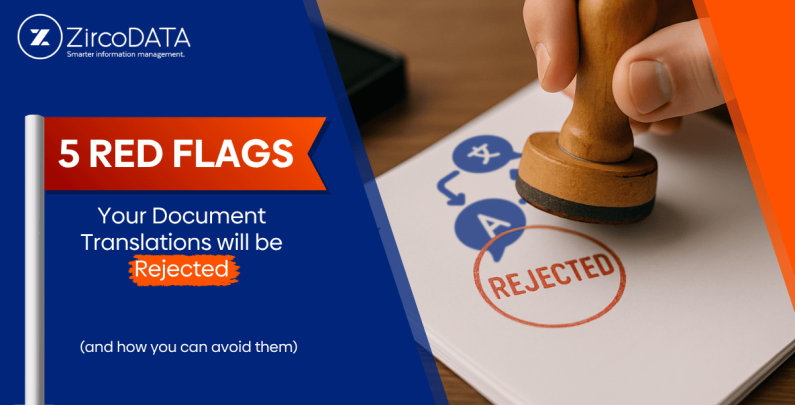
5 Red Flags your Document Translations Will be Rejected
With International Translation Day now behind us, one message stands out: translation has always connected people and institutions. The reality is that official documents must do more than read well. They need to be accepted on first submission in compliance-heavy environments like Australia. Credentials matter. Process matters. Knowing the receiving body’s rules matters. The five red flags below explain where document translations fail, and what you can implement in order to avoid them in the first place.
1) Your translation isn’t NAATI-certified
In Australia, acceptance is tied to responsibility that can be verified. NAATI is the national certifying authority for translators and interpreters and it provides a public directory so reviewers can confirm a translator’s certification (NAATI Online Directory). Government and regulator guidance often points directly to NAATI when they describe acceptable translations. AHPRA states that if a translation is incomplete or inaccurate it will request a translation completed by a translator accredited or certified by NAATI. Choosing a translator that is NAATI certified can help you demonstrate traceable responsibility, and it is often a requirement in public guidance and regulator policy.
2) Your translators aren’t experts in the document’s field
Fluent general language is not the same as correct language in specialist contexts. In healthcare the risk is measurable. A multicentre cohort study in JAMA Pediatrics found that children whose parents reported limited comfort with English had higher odds of adverse events during hospitalisation, a signal linked to communication and terminology gaps (JAMA Pediatrics study). For medical or legal files, selecting NAATI-certified translators with documented domain training reduces error pathways that reviewers are trained to look for.
3) Your approach to AI is all or nothing
In 2025, refusing AI entirely sets teams back because it removes useful assistance from drafting and terminology checks. Using only machine output for official documents strips away the human responsibility authorities expect. The relevant standards draw the line. ISO 18587 sets requirements for full human post-editing when machine translation is used and ISO 17100 governs the wider translation service process so roles, review and records are defined and auditable. NAATI recognises AI as part of a certified practitioner’s toolkit when expert oversight is present. Choosing a provider that selectively incorporates AI where appropriate and keeps expert humans responsible for the final wording aligns speed with acceptance.
4) There’s no evidence of an ISO 17100 workflow
Two translations can read the same. Only one survives administrative scrutiny because it was produced under a recognised, repeatable process. ISO 17100 defines the core processes, resources and review steps required to deliver a professional translation service that meets the agreed specification. A provider should be able to explain who translates, who reviews, how changes are controlled and what records are retained. If that chain cannot be described plainly, reviewers start asking questions and acceptance slows.
5) Translation service doesn’t understand regulations and requirements
Rejections often come from small mismatches with the receiving body’s rules. Australian regulators and universities publish these requirements in public. AHPRA outlines translation expectations for registration applications. UNSW’s Graduate Research Document Submission Guidelines require that non-English documents include both the original language and certified English translations. If the document will be used overseas, the legalisation path matters too. DFAT certifies the genuineness of signatures, stamps and seals and provides an online system to verify apostilles issued in recent years by number and date. Choosing a provider that understands and implements the destination organisation’s rules prevents gaps that create significant delays.
Avoiding these five red flags gives your documents the best chance of being accepted on first submission in Australia. That means using NAATI-certified translators, running work through an ISO 17100 workflow with ISO 18587 human post-editing when MT is appropriate, and aligning every file to the destination authority’s rules and any DFAT legalisation needs. If you would like this handled end to end, visit our Translation services page and we will scope your documents, confirm compliance requirements, and provide a clear turnaround.
